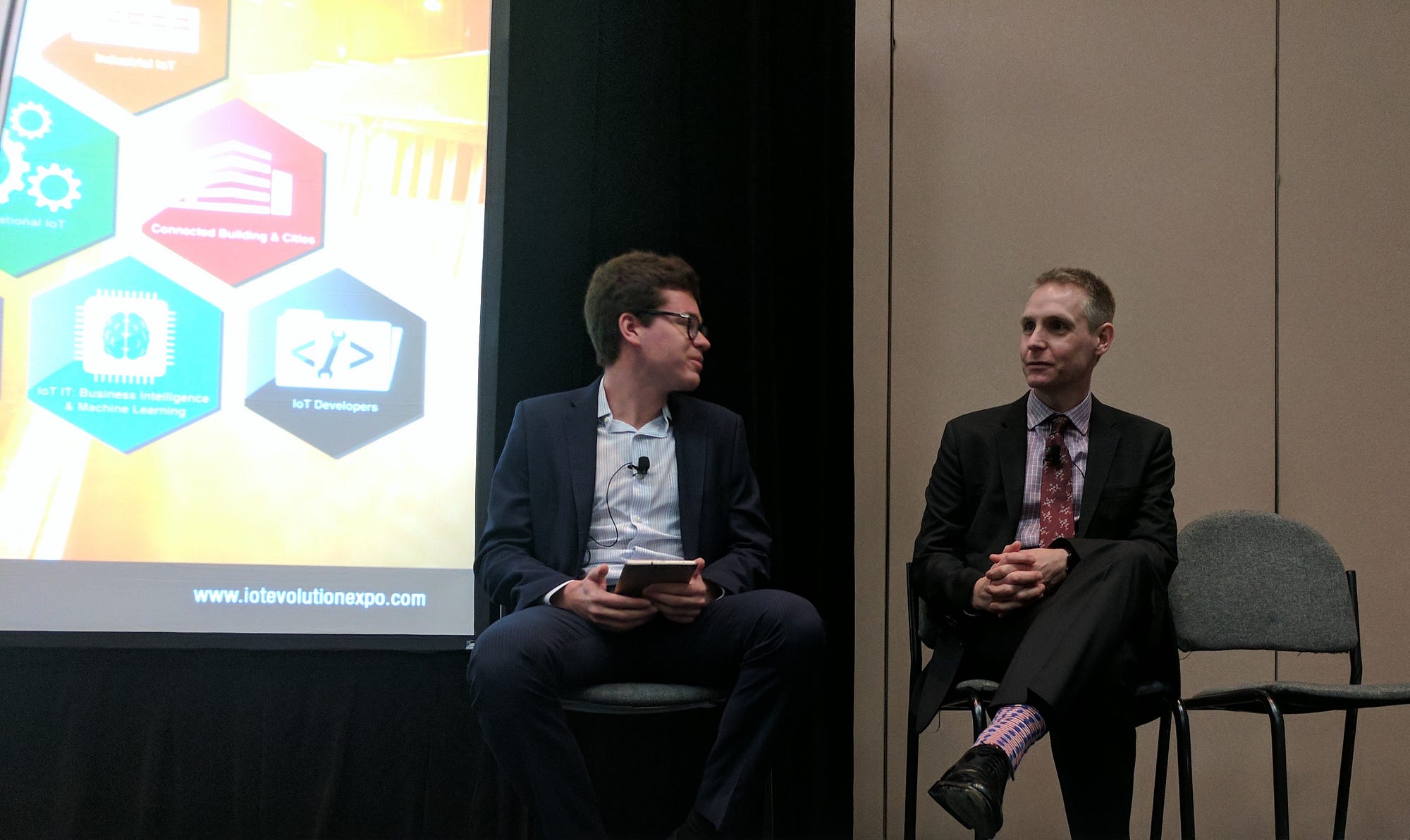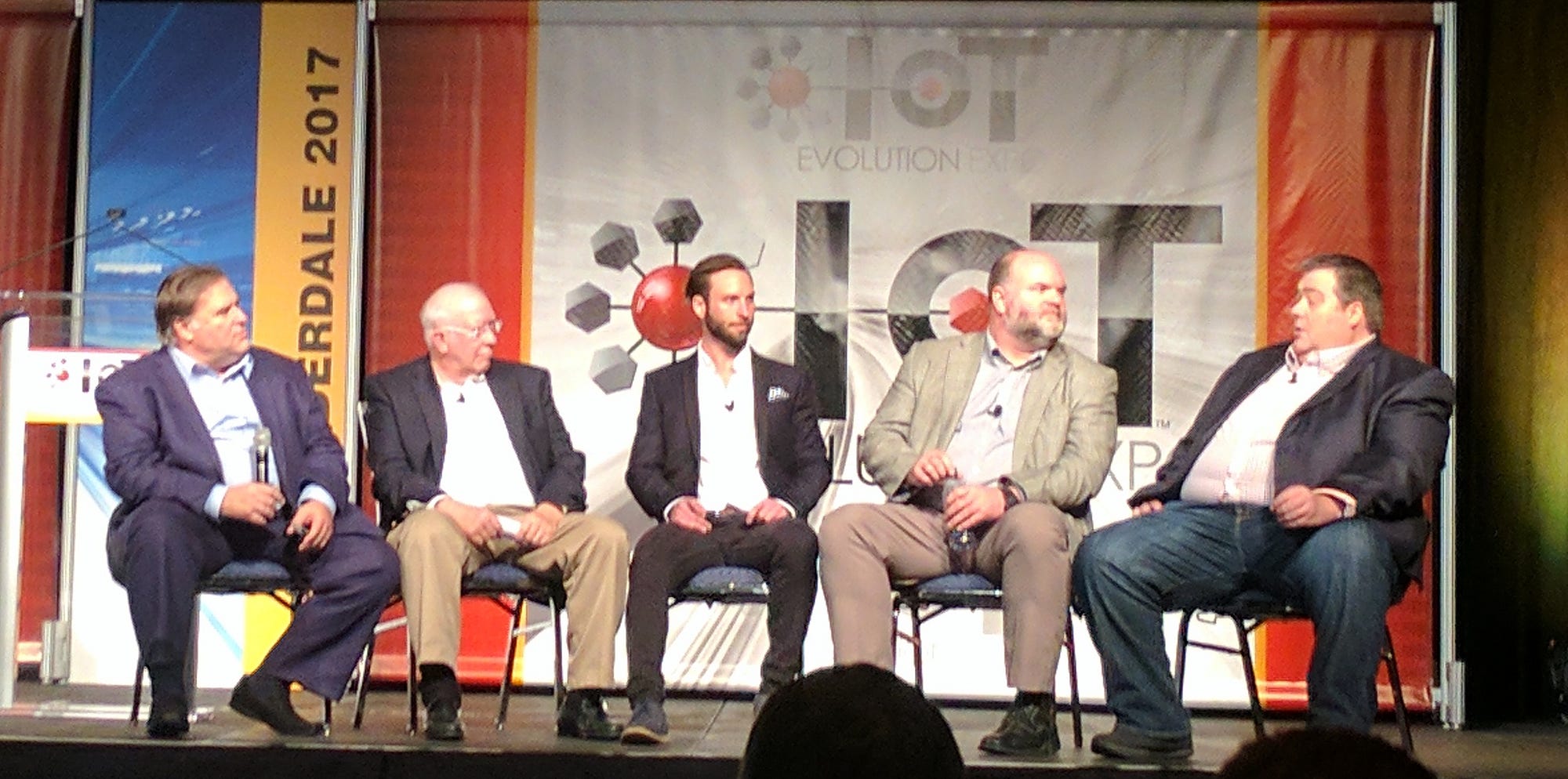Choosing the right Connectivity, Smart Cities, and Analyzing IoT
Choosing the right Connectivity, Smart Cities, and Analyzing IoT
- Last Updated: December 2, 2024
Calum McClelland
- Last Updated: December 2, 2024



My second day at IoT Evolution Expo was jam-packed with meetings, but I managed to sit in on a few interesting keynotes and presentations. Below you’ll find some of my takeaways from each.
Keynote from Ingenu: Five Surprises Awaiting IoT Device Makers
There are a lot of questions around LPWAN technologies, but there’s no question that LPWAN enables many important business cases not currently served by other connectivity options like cellular, satellite, Bluetooth, wifi, etc. Ingenu is a proprietary LPWAN technology that you should watch, they’re quickly rolling out across the US and internationally, promising much better performance than competitors like SigFox and LoRa.
- When choosing a connectivity option, it’s important to think about message acknowledgments (ACKs). Data goes two ways, from device up to gateway or cloud (uplink) and gateway/cloud to device (downlink). ACKs are downlink and many connectivity options have limited downlink capability. ACKs are important because, otherwise, you don’t know if critical data being sent from devices/sensors is actually reaching where it needs to go. NB-IoT, heralded as a competitor to LPWAN technologies, only acknowledges 50% of messages. If ACKs are important to your IoT Applications, Ingenu is a great option.
- Battery life is critical for many applications, you want sensors or devices that last 15–20 years because there may be tens of thousands of them in hard to reach places which would be expensive and time intensive to upgrade and/or replace. Sending messages draws most of the power, so it’s important to have a reliable network. It takes less power to send a message once, knowing it will be received, then sending it multiple times because of unreliability.
- A final consideration is firmware updates. It’s unrealistic to assume that a device won’t need to be updated over a 15–20 year span. However, due to limited downlink of many low power connectivity options, firmware updates are impossible (too much data). The ability to push firmware updates down to devices is an important factor to consider when choosing connectivity for your IoT application.

How Smart Cities’ IoT Capabilities Are Transforming the Workplace
Smart cities fascinate me and will likely be a big driver for IoT, so I checked out another smart cities focused talk today.
Some takeaways:
- One of the barriers for smart city implementation is that cities are already built, so we have to deal with legacy infrastructure. If we were starting from scratch, it would be much easier to integrate IoT into a city. I think this is true beyond smart cities too, it can take huge effort with much planning to roll out new IoT solutions in large companies.
- Planning, planning, planning. Many investments won’t see ROI until perhaps 10 to 15 years, let alone 1–2. This is why it’s critical that cities consider what they want to be as a city, what are their goals? Cities can have vastly different wants and needs, so there’s no one-size-fits-all solution. This is particularly important for cities because of the scale of investments and projects, but holds true for businesses too. First ask, what are you trying to accomplish?
- Collaboration is key, across departments and between public and private enterprises. Andrew gave an interesting example where an education department said they wanted to move everything in schools to Google Docs. A great idea on the surface, cutting down on expenses for families because they don’t need to buy books. But Andrew spoke to the housing department who said that 20% of homes don’t have broadband. So moving everything to Google Docs would actually make things worse and leave kids behind. Smart city solutions can’t be siloed, they need to involve everyone.

Panel Discussion: Analyze What IoT?
Moderator (Left):
Carl Ford — CEO of Crossfire Media
Speakers (Left to Right):
Gerry Purdy — Principal Analyst, Mobile & Wireless at Mobiocity
Ryan Martin — Senior Analyst, IOT, Analytics, Wearable Tech at at ABI Research
Andy Castonguay — Principal Analyst at Machina Research
James Brehm — Founder and Technology Evangelist at James Brehm & Associates
Gerry Purdy
- Gateways are misunderstood and under-appreciated by many people. For example, your phone is a gateway. It can connect via Bluetooth to your car and boom, now your car is connected to the internet via your phone. Gateways will be essential to the Internet of Things because they make it easier to get data from one place to another.
- Also, we need to be able to make sense of the huge number of devices now coming online. As a company, what’s on our network? What devices are alive or dead? Have any gone rogue? Gateways are a good way of meeting this need for keeping track of and managing all of the new devices.
- Finally, Gerry says it’s easy to take something simple and glorify it. It’s one thing to have a car drive autonomously along a highway, it’s quite another for it to take an off-ramp and navigate around new construction with a worker holding a sign and waving to go around. IoT isn’t easy, we still have a long way to go.
Ryan Martin
- When it comes to the cloud, the big benefit is centralized computing, being able to apply complex data analytics or machine learning. It’s been interesting to see the big companies like Facebook, IBM, Amazon, and Microsoft open-sourcing their machine learning libraries. This is an indicator of how difficult ML is, these companies can’t solve certain problems on their own so they need to get the help of the open-source community.
- When it comes to security, the issues aren’t new, much of it is human. If we look at credit card payments when they were new, there was a lot of fear and uncertainty. But now, we all trust them to work safely.
- Re-schooling and re-education are going to be essential. At AT&T, the average tenure is 12 years. Think about what you were doing just 12 years ago, the iPhone didn’t exist. Many jobs will drastically change or go away completely.
Andy Castonguay
- The past election was driven by a need for jobs and concern over job safety. If we’re honest, the technology we’re doing with IoT is in line with those concerns and needs to be addressed. When he gets in a cab or uber, he thinks about how, in 10 years, those jobs won’t be around. Technology is no longer a barrier, so we need to start recognizing and addressing the consequences.
- When it comes to things like CAT-M, LoRa, NB-IoT, SigFox, etc., they can all be lumped under LPWAN. The exciting thing is that this connectivity opens up an entire suite of applications that haven’t been addressed by cellular in the past. All these new technologies are opening up business cases that are pretty profound in terms of operational efficiencies.
- For security, it’s a nice idea to build everything secure, but not practical. Who is going to enforce a minimum layer of security design if it is regulated? Security needs to come on the network side rather than the device side.
James Brehm
- At the end of the day it’s all about data, so he’s interested in things that generate high volumes of data with contextualization and ability to clean that data.
- When talking about artificial intelligence, first, things need to be connected. Using cars as an example, there are currently 42 million connected vehicles in the US out of 200 million total. So first, establish connectedness, then work intelligence and autonomous driving in there.
- With over 700 IoT platforms, there is absolutely no way that they all survive. There are simply too many to be sustainable, they need to make revenue. There are many bad solutions out there, and not a lot of really good ones. Ultimately, there are too many device types and connectivity types for one platform to rule them all, but there will be consolidation because now there are too many.
Find out how you can stay updated on the latest at IoT Evolution Expo.
The Most Comprehensive IoT Newsletter for Enterprises
Showcasing the highest-quality content, resources, news, and insights from the world of the Internet of Things. Subscribe to remain informed and up-to-date.
New Podcast Episode

IoT and AI in 2026
Related Articles



